Growing Cucumbers - How to Grow Cucumbers Outside from Seed
No one likes bitter cucumbers. That is why we have this page for you to guide to on your way to successful cucumber growing, whether you are growing these lovely vegetables for summer salads, cool soups or of course pickling cucumbers that so many of us of fond of too.
You can grow cucumbers directly in the soil, in containers, vertically, or even start them off in hotbeds.
If you are unsure of when to plant cucumbers in your location see when to plant vegetables, as well as knowing when to plant them during the month for planting by the moon.
Growing Cucumbers on Frames or in Ridges
Frame cucumbers are so called because they are trained to climb up framework and to grow straight fruit. Ridge cucumbers are cultivars that are grown in ridges or hills or though there is no real reason why they cannot be grown on the flat. These are grown without support and allowed to ramble.
Growing Cucumbers by Seed
Cucumbers are usually grown by seed rather then seedlings, however, you can raise seedlings in small trays in a protected area and then plant them out when all signs of frost have gone.
How to grow cucumbers
outside? Plant cucumber
seeds in hills or ridges in your soil. Small hills are built to receive
the cucumber seed and to give your plants a good start.
The hills should be 3 feet
apart in each direction.
Make them
fifteen or eighteen inches in diameter, and a foot in depth; fill them
three-fourths full of thoroughly rotted compost,
and then place four or
five inches of earth over the whole, raising the hill a little above
the
level of the ground; plant 6-8 seeds in each hole, cover half
an inch deep, and press the earth smoothly over with the back of the
hoe.
When all danger from garden
pests
and worms is past, thin out the
plants;
leaving but three or four of the strongest or healthiest to a
hill. Be very careful when doing this as the plants are fairly shallow
rooted at this stage and you don't want to end up disturbing your
healthy plants too much.
Growing Cucumbers in The Right Soil Conditions
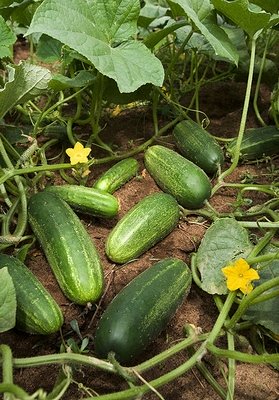 Growing
cucumbers in dry or very wet soils should be avoided.
Growing
cucumbers in dry or very wet soils should be avoided.
Cucumbers succeed best in warm, moist, rich, loamy ground with the ideal pH level at 5.5 - 7.0.
The ideal conditions for cucumbers to grow in requires heat, and a fair proportion of moisture.
They should not be planted or set in the open air until the cold weather has past and there is a good prospect of warm weather.
If cucumbers are planted early, not only are the seeds liable to decay in the ground, but the young plants are frequently cut off by frost.
In hot weather make sure that your cucumbers don't get burned either. Their large leaves are there to
protect them from the sun, but ocassionally you do find that this is not enough.
Growing Cucumbers in Containers or Vertically
As mentiontioned, cucumbers can also be grown in container gardens, but the pots or containers should be at least 30 cm in diameter, and 20 cm deep. This is because cucumbers have large leaves which take up a lot of space.Choose a variety such as Bush Champion for container growing, and pinch out the growing tips when the plant has about 7 leaves. Other cucumber varieties for container growing are Sweet Success, Bush Slicer and Liberty.
The Apple Cucumber is also a prolific grower and perfect for growing in small spaces.
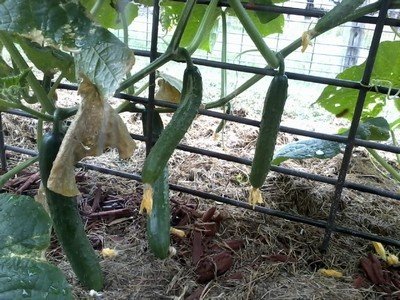
Growing cucumbers vertically against a wire frame
Types of Containers for Cucumber Growing
It really depends on what is available. You can grow cucumbers in commercial pots, be it plastic, or terracotta, or you can even find old buckets, tyres, polystyrene boxes and old baths to grow your vegetables in. I do like to recyle, but I am also aware of how untidy things may look too. So I am fairly careful with what I use, and how.If you are using buckets, just remember to drill enough weep holes in the bottom for drainage. This is so important because if you don't the soil will go sour and your vegetables will rot.
Watering your Cucumber Plants in their Containers
Because your cucumbers in their pots rely on you for their moisture you will need to make sure that your pots and containers don't dry out. People often fail at growing cucumbers like this because they forget to water or don't water enough. The pots will dry out a lot quicker than if they were in the soil, so make sure that the soil is moist at all times. However, there is definitely a balance. Don't over-water!So how do you get the balance right? You need to put your finger into the soil of your containers. If the soil 2 inches down is dry, water. If not, hold off for another day and then water.
Soil for Growing Cucumbers in Containers
Make your own potting soil. Yes, you can buy commercial potting soil, but if you make your own, you know that you have a good product.You can make your own container gardening soil by taking 3 parts of good garden loam, 1 part of moistened peat moss, and 1 part coarse river sand. Added to this should be some well-rotted farmyard manure or compost.
In addition to your organic material, you can add the following to every 8 liters of soil:
1/2 cup Epsom salts
1/4 cup coffee grounds (rinse them clean)
4 egg shells (dried and crushed to powder)
To get air into your soil and to make it lighter, add some granular polystyrene, or better still Perlite. A couple of cupfuls to your containers should be enough. Adjust according to the size of the container, but can make up 1/3 of the volume. Don't add too much as it is a water-repellent, and unless you add extra peat moss, you will find that your soil will dry out quicker than you want.
Finally I always add a good handful of blood and bone to give the vegetables a good start in their containers. I am also a fan of poultry manure more than any other for vegetables because of its high nitrogen content. Just make sure that it is not fresh, as it will burn the roots of your vegetables.
Growing Cucumbers in Containers and Fertilizing
Fertilizing your plants is very important. The have no where to send out their root system in search of nutrients. They rely totally on you. Cucumbers are also heavy feeders, so you will have to fertilize your plants at least once a week.This is why soil preparation for your containers is so important.
Fertilize with either a seaweed solution, liquid manure or compost tea. See below for more details.
Growing Cucumbers in Hot Frames and Hotbeds
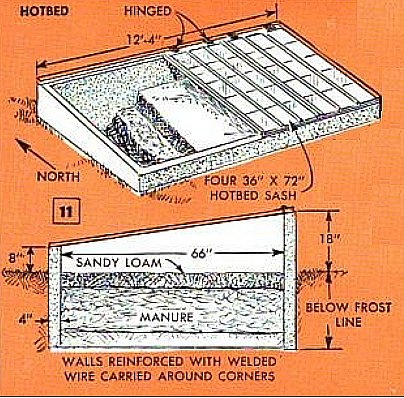
If you live in an area that gets snow and late frost, you may want to start your cucumbers off in cold frames and hotbeds so that they can be transplanted out, once the weather has improved.
Good compost, including leaf mold and rotted farm manure can be used as growing material.
Any manure intended to use in a hotbed must be turned over every 3 or 4 days and watered lightly until you are sure that most of the heat has been reduced from the pile.
Place the compost manure mix onto the ground, 2 - 3 feet wider than the frame itself and trample down to compact it lightly. At this stage it is still wise to place sticks or rods into the compost at various places to test the heat.
Once you are ready to plant, place the frame on top of the compost and then place a layer of soil inside the frame.
After the first day raise the sashes to allow circulation of air and the manure to sweeten and cool. Then place the cucumber seed into pots or trays, sowing thinly, and place the pots to half their depth into the soil. After the plants start to develop their leaves, then transplant into pots 2-3 to a pot. Use rich, light soil and tamper down after transplanting and water with tepid water. Again place the pots into the soil to half their depth.
Shade them from full sunlight for the first couple of days, and water well to encourage vigorous growth.
In the meantime start another hotbed in the same manner. In the first hotbed you can now take the plants out of their pots after a week or so, and transplant into the hotbed directly. Place in hills, as you would if you were planting outside making sure that the temperature in the hotbeds is kept between 85 - 90 degrees F. during the day, and no more than 10 degrees below that at night.
Continue to protect the plants from full sunlight. When the plants have started to make progress, pinch out the points to encourage lateral shoot growth. These again are pinched back in turn to the fruiting points until the frame has been filled. Once the weather warms up you can start opening up the frame during the day to let in the air.
Keep the shoots thin to encourage good air flow and adjust the temperature making sure that it doesn't fall too low by removing the original layer of manure lining the outside of the frame and adding more manure to the outside of the frame to a depth of 2 feet, all around, which will be higher than the original layer.
If your ground is warm enough your plants can be planted outside, however, they must be protected at night by either covering them up with cardboard or glass panes.
If you are planting them outside, again after the first pinching, the main vine should be allowed to grow, but the laterals should be stopped in the same ways as those in the hotbeds.
Manure in the form of mulches and liquid manure should be applied regularly while your cucumbers are growing as cucumbers are voracious feeders and will need lots of feeding. You can never feed cucumbers too much.
Growing Cucumbers and Looking after your Plants
They also like a feed of an organic soluble potash fertilizer when the fruits start to set.
Growing Cucumbers and Knowing When to Harvest and Pick
As soon as the cucumbers reach a suitable size, usually after 8-10 weeks, they should be picked, whether required for use or not. The imperfectly formed, as well as the symmetrical, should all be removed. Fruit, however inferior, left to ripen on the vines, soon destroys their productiveness. The fruit should be removed with a sharp knife or a pair of secateurs about twice a week.
Growing Cucumbers and Crop Yield
Well that really depends on the growing conditions and the varieties. However, if you are growing cucumbers in a greenhouse, expect 10-12 cucumbers per plant. If you are growing cucumbers outdoors, then your yield will be a little less. However, for large yields, you really need to water cucumbers well, and mulch the plants to keep the moisture in the soil for longer.
Growing Cucumbers and Identifying Diseases and Pests
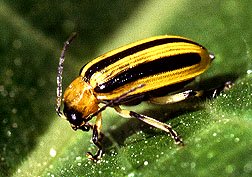 When you learning how to
grow cucumbers you should also be aware of the types of
pests and diseases that attack this vegetable.
When you learning how to
grow cucumbers you should also be aware of the types of
pests and diseases that attack this vegetable. The most common pests for cucumbers are aphids, red spider mites, cucumber beetles (image left) and fruit flies. If you plant catnip (nepeta cataria) as a companion plant with cucumbers you will find that the catnip will repel cucumber beetles and aphids in your vegetable gardens.
See garden pests for identification.
Cucumber Beetle
Cucumbers are also susceptible to diseases like powdery and downy mildew.
Mildew on plants is a fungal disease that often occurs with humid weather and watering plants in the evening where the moisture is retained by the leaves. It is better to water in the mornings, allowing the sun to dry the leaves off, minimizing the chance of mildew from attacking your plants. See our section on organic pesticides to get rid of these pests from your vegetables.
If you notice white patches on your cucumbers that are oval in shape and found on the upper-side of your cucumber fruit this is sun scorch. It normally happens towards midsummer when the sun is beating down and the foliage is starting to deteriorate and not being able to protect the plants. The only remedy is to make regular pickings.
Growing Cucumbers and Saving the Seeds
It makes sense to save seeds of good vegetable varieties. When a few seeds are needed for the vegetable garden, two or three of the finest-formed cucumbers should be selected early in the season, and allowed to ripen on the plants. In September, or when fully ripe, cut them open, take out the seeds, and allow them to stand a day or two, or until the pulp attached to them begins to separate; when they should be washed clean, thoroughly dried, and packed away for future use.
Growing Pickling Cucumbers
The land for raising pickling cucumbers must be in good condition, and not easily affected by drought. It should be deeply plowed, and the surface afterwards made fine and friable by being thoroughly harrowed. The hills should be 3 feet apart, and are generally formed by furrowing the land at this distance in each direction. Manure the hills with well-rotted compost, level off, draw over a little fine earth, and the land is ready for planting.
This may be done at any time from the middle of June to the first week in July. The quantity of seed allowed to an acre varies from three-fourths of a pound, upwards. In most cases, growers seed very liberally, to provide against being eaten by worms and bugs; usually putting six or eight times as many seeds in a hill as will be really required for the crop. When the plants are well established and beyond danger, the field is examined, and the hills thinned to three or four plants; or, as many plants required.
As fast as the cucumbers reach the proper size, they should be picked; the usual practice being to go over the crop daily. In gathering, all the fruit should be removed,—the misshapen and unmarketable, as well as those which are well formed; as when any of the crop is allowed to remain and ripen, the plants become much less productive.
Troubleshooting Questions & Answers for Growing Cucumbers
A. No. They should be removed from the vines. Misshapen cucumbers may result from poor pollination or low fertility. Side-dressing with a complete fertilizer may help later cucumbers to develop normally.
Q. Why do some of my plants suddenly wilt and die? Dead or dying plants are scattered all over my cucumber patch. One plant in a hill may be healthy, while another dies.
A. These are typical symptoms of the bacterial wilt disease. This disease is spread by cucumber beetles early in the season. The beetles must be controlled immediately when the plants are small.
Q. Is there really a "burpless" cucumber?
A. Yes. Burpless cucumbers are no longer considered novelties and are offered in most garden catalogs. They are mild, sweet and crisp when fresh. The skin is tender and free of bitterness, although many people peel it off. Most varieties are long (10 to 12 inches) and curved, unless grown on a trellis. These varieties are better eaten fresh, using conventional varieties for most pickling uses.
Q. What cucumber variety should I buy for gherkins?
A. Buy the West Indian gherkin. It is a close relative of the garden cucumber used for pickling. The fruits are generally oval, 1 to 3 inches long and more spiny than cucumbers. They are also called "burr cucumbers" but are usually listed in catalogs as West Indian gherkin. They are grown in the same way as cucumbers. Small-fruited, prickly varieties of cucumber are sometimes sold as "gherkins." If small, tender cucumbers are what you want to pickle and call "gherkins," then these misnamed cucumber varieties serve the purpose well.
Q. Why do my cucumbers fail to set fruit and yield properly?
A. The first yellow flowers appearing on the plants are male flowers that provide pollen. These flowers normally drop off after blooming. The small cucumber is evident at the base of the female flower (even before it opens) and should develop into an edible fruit if properly pollinated. Anything that interferes with pollination of the female flowers reduces fruit set and yield, including cold temperatures and rainy weather that hamper bee activity or improper use of insecticides that kill bees.
Q. What are gynoecious hybrids?
A. Gynoecious ("female-flowering") hybrids are special hybrids of slicing and pickling cucumbers that are advertised in many garden catalogs. Because they have all female flowers, they may be earlier and higher yielding than other varieties. Usually, the seed company mixes in a small proportion of seed of a standard cucumber as a pollinator.
Q. How far away from melons should I plant my cucumbers? I am concerned about cross pollination.
A. Contrary to popular opinion, cucumbers do not cross-pollinate with muskmelons or watermelons and cause them to become bitter, tasteless or off-flavor. Because cucumbers and melons require considerable space in the garden, however, plant the rows far enough apart for proper vine growth without overlapping.
Q. What causes my cucumber plants to be stunted? The leaves are a mottled yellow, and the fruits are blotchy and taste bitter.
A. This condition is caused by the cucumber mosaic virus. Grow mosaic-resistant varieties.
Q. What causes the white mold growth on the upper surfaces of my cucumber leaves?
A. This condition is caused by powdery mildew, a fungal disease that is most severe during late summer and fall plantings. Grow resistant varieties.
Countryfarm Lifestyles: 10 Tips on Growing Cucumbers:
- As the summer wears on you will need to shade your cucumber fruit and continue to make sure that your soil doesn't dry out.
- By pruning your cucumber plants so that you restrict the length of the main vines and encourage side growth by pinching out the trailing shoots from time to time will increase your crop enormously.
- Peg the stems to the ground to prevent the plants from being broken off in windy or stormy weather.
- Pick the cucumbers as soon as they are of a useful size. Never allow fruit to ripen on the vines unless you are saving seed.
- Remove the side shoots from areas where most of the cucumbers have been harvested to allow light and air into the plants.
- Top dress liberally with diluted liquid manure during crop growth from time to time.
- The more you pick, the more cucumbers you will get.
- The season can be extended at the end by removing the old stems that are no longer bearing fruit and feeding the remaining plants with diluted liquid manure.
- Cucumbers are heavy feeders so make sure that your soil is rich with mulch or manure before you start and continue to feed them throughout the growing season.
- Cucumbers should always be eaten crisp. To keep them that
way, after you pick them place the stem end in a bowl of shallow water,
as you would flowers, until needed. Refresh water daily.
Did you find this page helpful?
Sharing is a way of saying, "Thanks!"
Follow Us and Keep Up to Date
AND OTHER VEGETABLES
You can Add your Own Comments and Pages on Growing Cucumbers!
We have lots of pages where you can contribute to throughout this homesteading website. We love hearing from our readers, and hope you will be one of those we hear from too. Feel free to write about your own experiences in growing cucumbers.You can do this by using the form below.
Leave a Comment
Do you have anything that you would like to add after reading this page? We would love to hear your thoughts. If you can add additional information to what has been written here you will be adding value to the website! No need to have any special skills - just type and submit. We will do the rest!





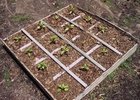


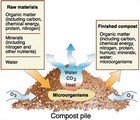


New! Comments
Do you have something of value to add? Leave me a comment in the box below.